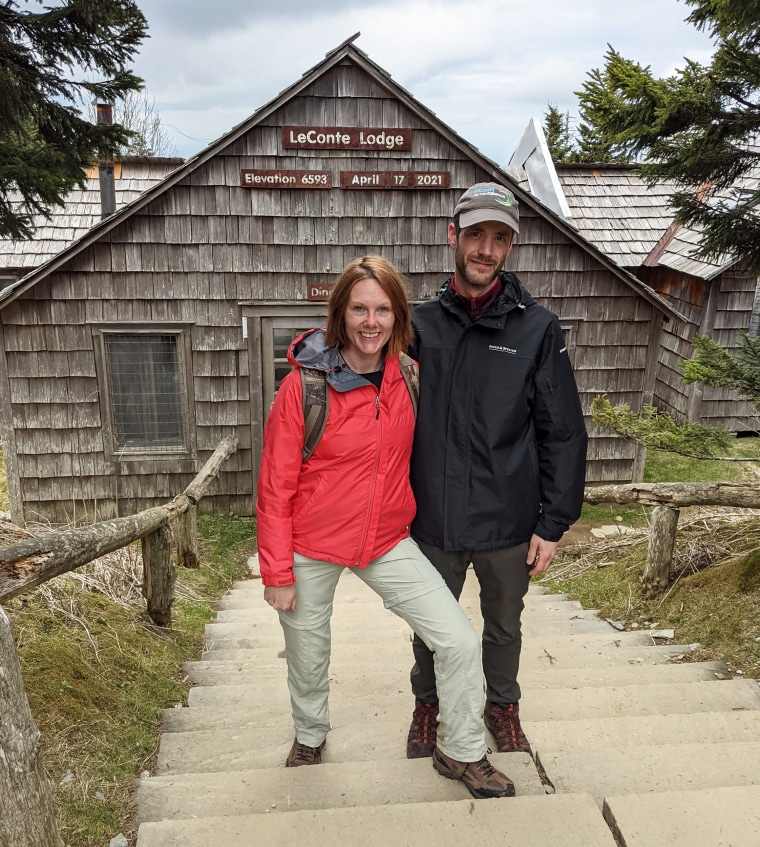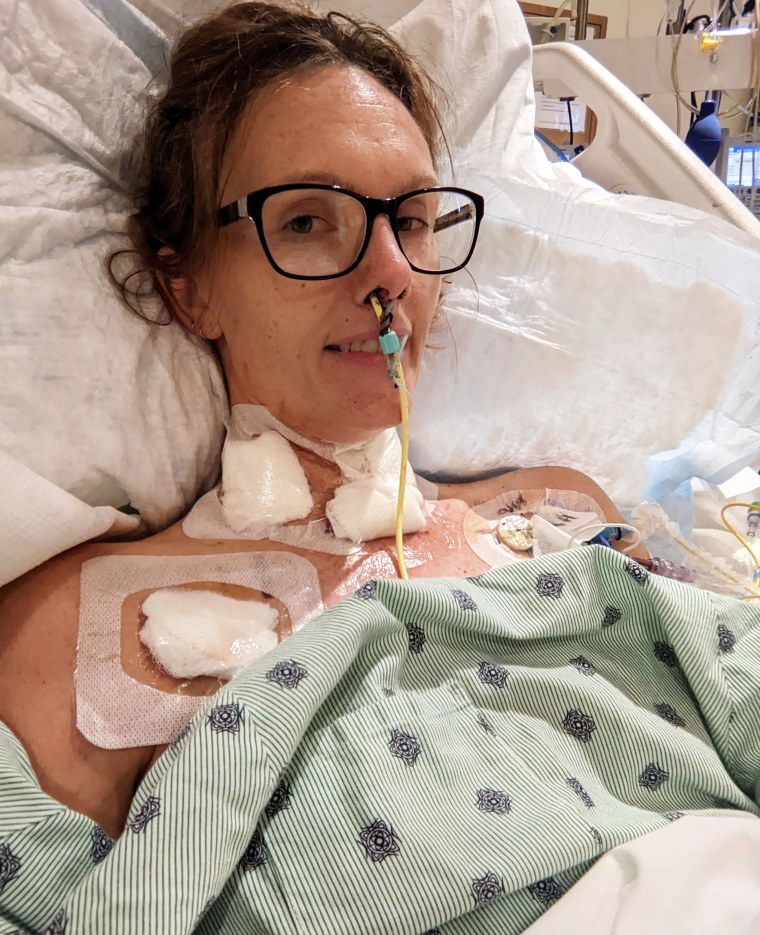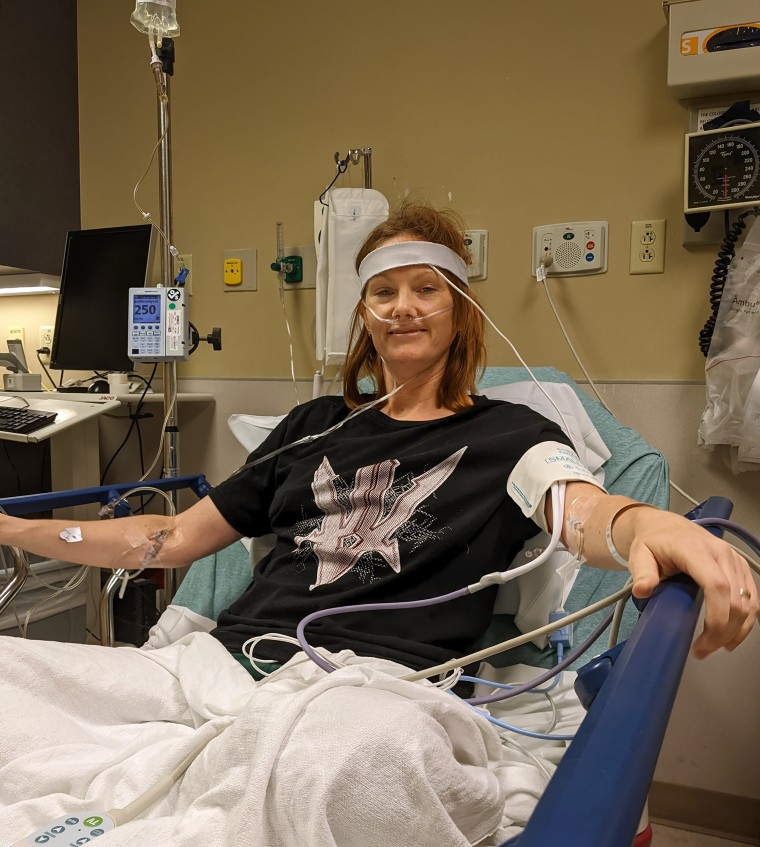When Jamie Waddell tested positive for COVID-19 for the first time in August, she was much sicker than she expected. After 10 days, she felt better and returned to school and work. But a few weeks later, she noticed she struggled to walk down the street without feeling faint. Soon, she couldn’t talk without getting winded. By Labor Day, she was so sick that she visited the emergency room, where she learned she had sepsis, pneumonia and heart failure.
“Based on the fact that I kept feeling worse and worse, I’m guessing my heart function had probably been declining over that whole week, and by the time I got to the ER, I was septic,” Waddell, 36, a nurse from Springfield, Illinois, tells TODAY.com. “They did an echocardiogram. My heart function was really low. I was in heart failure.”
Feeling faint while walking
In early August, Waddell and her husband were preparing to go on vacation and tested positive for COVID-19. She was vaccinated and boosted and felt surprised by how sick she felt.

“Body aches, fatigue, fever, your respiratory stuff, sinus congestion — I was sick for about 10 days before I started to feel better,” she says. “I did start to feel better. I was back to work. I was actually going to school and started.”
After returning to work and school, on Aug. 28, she took a walk, something she usually did for three to five miles a day. But when she was about a half mile from her house, she began to struggle.
“I felt awful, like very faint. I was walking down the street going, ‘Oh God, don’t pass out,’” she recalls. “That’s unusual for me. I am pretty active.”
At first, she worried she pushed herself too hard after recently having COVID-19.
“Maybe I just took too long of a walk. It was fairly warm that day,” she says. “I didn’t think anything of it and went to work the next day.”
Two days later, she was coughing and achy and asked her doctor for a chest X-ray, which came back normal. She called off work two days and went to her local urgent care clinic. She did not test positive for COVID-19 or flu.
“My vital signs at that visit were a little off. My heart rate was a little high. I had a fever,” she recalls. “I came home and basically went to sleep.”
But her symptoms intensified. She experienced body aches, cough, “overwhelmingly bad” fatigue and vomited.
“At that point, I knew something was wrong. You’re not getting better, you’re just feeling bad,” she says. “You can barely move.”
That’s when Waddell went to the emergency room.
“My blood pressure and oxygen levels were really low,” she says. Pretty much immediately, they could tell something was wrong.”
“My lactic acid was high, which is a sign of sepsis, and they did a CT scan, and I had pneumonia pretty bad,” she says. “That is about the last thing I remember. I woke up 10 days later in Chicago.”

Doctors suspected that COVID-19 caused Waddell to develop myocarditis, when the heart muscle becomes inflamed.
Myocarditis and COVID-19
For decades, cardiologists have been trying to understand why some young people experience myocarditis after a viral infection. COVID-19 has also been known to cause the condition, even in seemingly healthy people, Dr. Bow “Ben” Chung, an advanced heart failure specialist at University Chicago Medicine who treated Waddell, tells TODAY.com.
He explains that prior to the pandemic a number of viruses — such adenovirus, coxsackievirus and parvovirus — that usually result in a mild infection would sometimes go on to cause "a very significant heart failure reaction." But it's "still very unclear" why heart failure occurs in some patients and not others.
By the time Waddell reached her local hospital, doctors needed to act fast to support her. They implanted an Impella, a temporary device to help her heart pump blood. Patients in heart failure normally need help with the left side of the heart, where Waddell's device was placed. But her doctors noticed the right side of her heart also struggling, so they implanted another Impella made especially for that side.
“The right side of the heart is very often forgotten. It’s actually the more difficult side to deal with, too,” Dr. Christopher Lawrance, a cardiovascular surgeon and assistant professor at Southern Illinois University School of Medicine, tells TODAY.com. “When we put the right side Impella in, … literally within minutes she just started dumping urine, which is a good sign that her organs are actually getting good blood flow, and that was just a cool thing.”
But the doctors in Springfield still worried about how sick Waddell was. They thought she'd need a new heart, so she was transferred to Chung's care at the University of Chicago, one of a handful of transplant centers in the country.
“The amount of life support that she needed when she arrived at the University of Chicago was pretty much the most amount of life support that somebody can do,” Dr. Abdul Hafiz, structural heart disease specialist and assistant professor at Southern Illinois University School of Medicine, tells TODAY.com. “Her heart and lungs were basically not working at the time.”
Chung adds: “Anybody who’s on that level of life support, you'd be thinking about a heart transplant for them because there’s a million machines and wires and tubes sticking out of the patient. You think the only way they make it out of the hospital is just by replacing (the heart).”

But after having the two temporary Impella devices implanted, Waddell slowly began improving to the point where it seemed like she would not need a transplant.
“We were amazed,” Chung says. “It was miraculous. … Jamie was listed for a heart transplant. ... If a heart transplant offer had come for her, we might have potentially even accepted the offer.”
Recovery
After waking up in a hospital room in Chicago, Waddell slowly gained strength and started thinking clearly. Then, she learned what she had been through.
“It was definitely surprising to learn that my heart was doing so badly. Again, just nothing I ever would have expected given my lifestyle,” she says. “It’s shocking to go from a person who is very active and no health history whatsoever to needing a new heart.”
In some ways, her recovery was quicker than she expected.
“I was pumping my own blood and breathing my own oxygen, and I was discharged three days later,” Waddell says. “I was in really bad shape and then all of a sudden, I wasn’t.”
Waddell lost a lot of muscle during her time in the hospital — almost three weeks in total. She could walk, but it felt difficult, and she started physical therapy. Now, Waddell sees a cardiologist and needs some medications. She hopes her story encourages people to seek help when something seems off and to rest when they’re sick.
“I work too much. So that’s definitely something that after you’re sick, that ... makes you realize if you’re not feeling good, you should take the time to rest,” Waddell says. “Appreciate your body for what it can do.”
CORRECTION (Jan. 4, 2023, 12:43 p.m. ET): A previous version of this article misspelled Dr. Christopher Lawrance's last name. It's spelled Lawrance, not Lawrence.